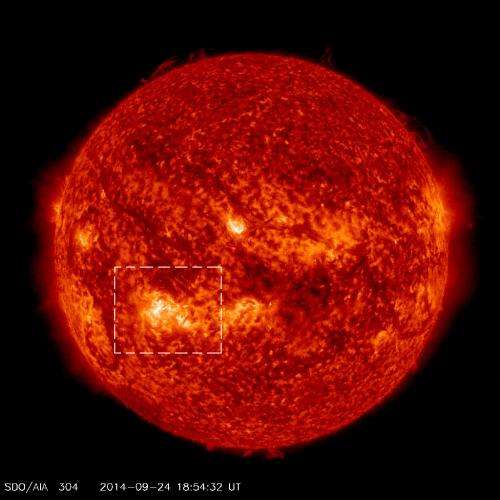NASA rocket has six minutes to study solar heating

(Phys.org) —On Sept. 30, 2014, a sounding rocket will fly up into the sky – past Earth's atmosphere that obscures certain wavelengths of light from the sun—for a 15-minute journey to study what heats up the sun's atmosphere. This is the fourth flight for the Very high Angular Resolution Ultraviolet Telescope, or VAULT, will launch from the White Sands Missile Range near Las Cruces, New Mexico.
The instrument, now called VAULT2.0, has been refurbished with new electronics and an imaging detector to capture images more frequently than before. While in space, VAULT2.0 will observe light emitted from hydrogen atoms at temperatures of 18,000 to 180,000 degrees Fahrenheit.
"That's the temperature range where the action is," said Angelos Vourlidas, the principal investigator for VAULT2.0 at the Naval Research Laboratory in Washington, D.C. "These are the temperatures where the heating of the sun's atmosphere – the corona—really takes place."
Understanding how the corona heats remains one of the great, unanswered questions on the sun. The solar surface itself is only about 10,500 F, but further up in the atmosphere, the temperatures rise to million of degrees Fahrenheit – the opposite of what one typically expects when moving away from a heat source. Something heats up that corona, and VAULT2.0 will be watching.
The sounding rocket will fly up to about 180 miles in the air, just below the height where the International Space Station travels. It will fly in an arc, taking 15 minutes from launch to landing back on the ground. This allows for just six minutes of actual observations while it is above the atmosphere, during which VAULT2.0 will capture an image every six to eight seconds. Vourlidas plans to focus the telescope on active regions at the center of the sun – areas of intense and complex magnetic activity, to understand the heating process there.
During the VAULT2.0 launch, three other observatories will watch the same area: NASA's Interface Region Imaging Spectrograph, or IRIS, the joint Japanese Exploration Agency and NASA's Hinode, and NASA's Solar Dynamics Observatory, or SDO. IRIS focuses in on solar material slightly hotter than does VAULT2.0, while Hinode can see solar material both cooler and much hotter. The temperatures also loosely correlate to heights in the atmosphere with the cooler temperatures at the bottom, and the hotter temperatures higher up. SDO will observe the larger scale structure of the solar atmosphere as well as the underlying magnetic field.
"Together the three telescopes will be looking at a sandwich of solar material," said Vourlidas. "We'll be looking at the layers from near the surface all the way up into the corona, the layers where the bulk of coronal heating is believed to happen."
VAULT's launch time is planned for 1:47 p.m. EDT on Sept. 30. Launch timing will depend on good weather conditions as well as optimum times for coordinating with Hinode satellite and IRIS spacecraft.
Provided by NASA



















